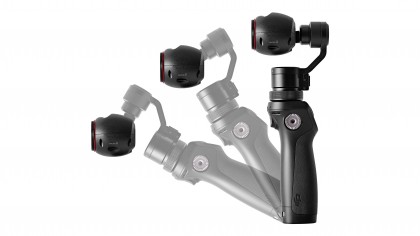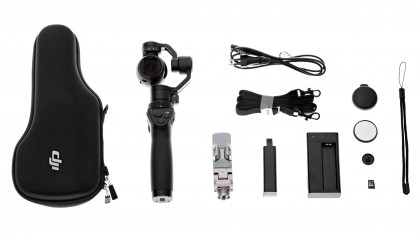Is Osmo the new GoPro? DJI invents a new way of filming
Action cams, grips and gimbal heads aren't new, but the magic happens when they're made to work together

The DJI Osmo is a world first, a compact stabilised 4K camera system that has the potential to revolutionise the way we capture video. The combined camera and brushless motorised gimbal enable the capture of smooth, shake-free footage with minimal equipment, meaning that now anyone with imagination can capture cinematic video like the pros.
The Osmo's handheld approach means that complex filming techniques such as motion panning are now possible with a one man crew and no specialist equipment such as trolleys or jibs are needed.
The Osmo is by no means the first motorised gimbal of this size as there are already accessories for action cameras that have been around for some time – but nothing comes close to the complete control that a fully integrated grip, gimbal, camera and smartphone app offer.
Check out the video below to get an idea of what the DJI Osmo can do.
Smart design
The Osmo looks to have been designed direct from the pages of a spy novel, with the eyeball-shaped camera fixed to the harness of a motorised gimbal, which is then connected to the control handle. The whole system is modular, so if you own a X5 or X5R gimbal camera already then those are also compatible and can be interchanged. A price for the handle on its own has yet to be confirmed.
The control handle is well engineered, and although made of plastic it's nicely finished with an ergonomically shaped and textured grip. Around the top are a series of buttons and a jog wheel that enables you to adjust the rotation and tilt of the camera – you even have an option to lock the orientation, which can be useful if you're doing a panning shot.

Not only does it enable the same smooth footage that you'd expect from a stabilised rig such as a Steadicam, because it's motorised it also features a series of impressive pre configured gimbal modes. These include a selfie mode which enables you to record yourself, something that will appeal to bloggers and reporters. Using this mode the camera automatically locks onto the presenter and captures smooth steady footage without the need for a cameraman, although the usual selfie pose is required. Other modes include follow mode, fixed, inverted and torchlight.
Sign up for breaking news, reviews, opinion, top tech deals, and more.
Choice of camera
Whilst the motorised gimbals designed for action cameras work incredibly well, they remain pretty basic, with limited user control and functionality. The greatest limitation can often be the camera itself even when that camera is the excellent GoPro Hero4 Black.
The Hero4 Black is designed to capture fast paced action rather than more sedate handheld footage, and as such it has visual properties to suit its design, including a wide-angle distorted lens optimised for subjects and scenery at a distance rather than close-up.
This difference in use of camera has been a major consideration for DJI.
The majority of cameras used on DJI's drone ranges use fixed lenses with focus optimised between 3.5m and infinity. This is great for aerial shots, but not so great if you're filming at closer quarters. In the Osmo, DJI is using its X3 camera, which already features on the Inspire 1, but here it has been adapted for ground level use, with a focus optimised between 1m and infinity. This change makes a huge difference to the image style and ultimately the quality of the footage and how it can be used.
The small camera features 4K as well as HD ability, with a 94 degree field of view lens (20mm equivalent) and a 1/2.3-inch sensor – this is the same size you'd expect in a regular compact digital camera.
Footage or stills, depending on your selected mode, are all captured on a micro SD card. If you want to record audio then there's a standard 3.5mm audio jack on the front of the handgrip. At the moment this only enables automatic gain control, which will annoy even the mildest audiophile. You'll also find a standard 1/4-inch tripod mounting hole on the side, so accessories or tripods can be attached.

The Osmo in use
Clicking the mode button for the camera quickly shifts through the different smart filming functions including Panorama, Long exposure and Slow Motion. The slow motion ability is impressive with the capture of full 1080p footage at 120fps, enough to slow real time down one quarter speed. There are other modes for stills as well as video, such as Panoramic and Long exposure, which enable you to pan or capture a long exposure without the need for a tripod as the gimbal keeps the camera steady.

Mounting options
DJI recognizes the crossover with action cameras and alongside the launch of the Osmo there will also be a series of mounting options both for the camera and its accessories. Amongst the most interesting of these will be the bike and suction pad car mounts, all of which meet the same design and quality as DJI's other products. For accessories there ars options for tripod mounting, extension rods, universal mounts, bike mounts and extension arms so that a smartphone can be fitted.
As with DJI's drone products, the Osmo is also fully integrated with iOS and Android devices and the app enables you to interact with the camera to adjust further settings adjustments as well as control over the operation of the camera and gimbal.
The Osmo is a fascinating device and the possibilities it offers anyone wanting to capture video are immense. The design and concept are new but this does look like it could change the way many of us think about and use video. The Osmo will go on sale for £549/US$649. We'll bring you a full review and opinion once we have a full production model.
See also:
Ali Jennings is the imaging lab manager for Future Publishing's Photography portfolio. Using Imatest Master and DxO Analyser he produces the image quality tests for all new cameras and lenses review in TechRadar's cameras channel. Ali has been shooting digital since the early nineties and joined Future's Photography portfolio back in 2003.